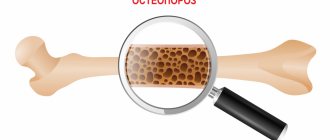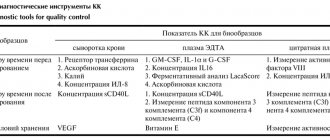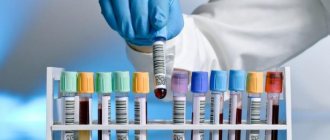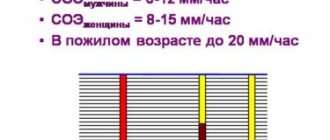Myoglobin is a protein found in the heart and skeletal muscles.
It traps oxygen in muscle cells, allowing them to produce the energy needed for muscle contraction. When the heart or skeletal muscles are damaged, myoglobin is released into the blood, where it circulates for several hours. It is then filtered from the blood by the kidneys and excreted from the body in urine. High concentrations of myoglobin are toxic to the kidneys, and in severe injuries, the release of myoglobin into the blood can lead to kidney failure.
Myoglobin can be used as an auxiliary test in the diagnosis of myocardial infarction, but it is not specific for this disease, since it is released into the blood when any muscle is damaged. One of the common causes of a sharp increase in myoglobin in the blood is rhabdomyolysis, the rapid breakdown of muscle tissue. It can be caused by severe injuries (for example, in a car accident), electric shock, burns, thrombosis, intoxication, certain infections (HIV, influenza, streptococcus), uncontrolled diabetes, hypo- and hyperthyroidism, and late-stage muscular dystrophies.
Detailed description of the study
Myoglobin is a specific protein found in muscle cells of skeletal muscles and the heart. Also, a small part of the protein can be synthesized in blood vessels, liver, and brain. It has a greater affinity for oxygen than hemoglobin. This determines two important functions of protein - the accumulation of oxygen in tissues and its use at critically low levels of oxygen in the muscle. Oxygen is transported to the mitochondria, where reactions occur to produce energy for the cells.
Myoglobin enters the blood when the myocardium and skeletal muscles are damaged. Myoglobin analysis is most often used to diagnose heart damage - myocardial infarction. It manifests itself as severe pain in the chest area, pain can radiate to the left arm, jaw, and stomach. Sweating, shortness of breath, nausea, and loss of consciousness are also sometimes observed. Symptoms mainly occur at rest.
The advantages of myoglobin include the fact that this protein is the earliest marker of myocardial infarction. It very quickly enters the bloodstream when cardiomyocytes (heart muscle cells) are destroyed and can be detected within an hour after a heart attack. The indicator reaches its highest values after 4-12 hours and returns to normal within 24 hours. However, this analysis is not specific for infarction, therefore, to clarify the diagnosis, the analysis should be performed together with the determination of other markers of myocardial damage (troponin and creatine kinase-MB).
Myoglobin levels also increase when skeletal muscles are damaged due to the following diseases:
- Myositis is inflammation of muscle tissue. Symptoms include fever, muscle weakness and muscle pain.
- Myodystrophies are mainly represented by Duchenne or Becker muscular dystrophy. They are hereditary diseases and are accompanied by paresis, paralysis, cardiac disorders, and damage to the respiratory system. Duchenne muscular dystrophy manifests itself in early childhood with rapid progression of symptoms and immobility. Becker's dystrophy has a milder course, debuts later, at the age of 10-20 years, and is characterized by slowly increasing muscle weakness, which allows people with this disease to maintain the ability to walk independently for a long time.
- Compression syndrome, which occurs when long-term compressed areas of the body are released by heavy objects (during natural and man-made disasters, landslides). As a result, toxic substances (myoglobin, creatinine, potassium and calcium ions, lysosomal enzymes, etc.) are released into the blood from damaged tissues, which can lead to acidosis (increased blood acidity) and the development of renal failure.
It must be said that myoglobin is excreted unchanged by the kidneys. If their function is impaired (kidney failure), the level of protein in the blood may be elevated. Excessive protein excretion also has a negative impact on kidney function.
Thus, determining the level of myoglobin in the blood serum together with other markers makes it possible to timely diagnose myocardial infarction and diseases associated with damage to skeletal muscles, and therefore prescribe treatment in a timely manner and reduce the risk of complications.
Material and methods
The myoglobin content in the blood of 30 (19 men and 11 women aged 41-94 years) corpses who died as a result of acute cardiovascular failure and chronic coronary heart disease was determined. Blood sampling was carried out at autopsy no later than 35 hours after death. Blood was taken in an amount of 10 ml with a dry syringe from the femoral vein of the corpse into a sterile bottle, according to paragraph VII, Chapter 88 of Order No. 346n of the Ministry of Health and Social Development of the Russian Federation. dated 12.05.10 “On approval of the procedure for organizing and conducting forensic medical examinations in state forensic institutions of the Russian Federation.” Two methods were used: a passive hemagglutination reaction with the erythrocyte diagnosticum DS-ERYTHRO-MYOGLOBIN NPO Diagnostic Systems and an immunoturbidimetric test with the DiaSys Diagnostic Systems GmbH kit. The technique using erythrocyte diagnosticum is semi-quantitative: a visual assessment of the presence of hemagglutination is made depending on the degree of dilution of the test sample. Immunoturbidimetric test - quantitative: a fixed time method is used. It is based on the photometric measurement of the antigen-antibody reaction between anti-human myoglobin antibodies immobilized on latex particles and the myoglobin present in the sample. Statistical processing of the results was carried out using the BIOSTAT software package. Spearman correlation was used to analyze the correlation between the data from the two samples.
References
- Kuleva, N.V., Krasovskaya, I.E. New role of myoglobin in the functioning of cardiac and skeletal muscles. Biophysics, 2021. - T. 61(5). — P. 861-864.
- Clinical protocol for the diagnosis and treatment of progressive Duchenne/Becker muscular dystrophy, 2021. - 19 p.
- Chaulin, A.M., Duplyakov, D.V. Biomarkers of acute myocardial infarction: diagnostic and prognostic value. Clinical practice, 2021. - No. 3.
- Clinical protocol for the diagnosis and treatment of idiopathic inflammatory myopathies, 2021. - 29 p.
- Clinical laboratory diagnostics. National leadership. In 2 volumes / ed. V.V. Dolgova, V.V. Menshikov. - M.: GEOTAR-Media, 2012. - 928 p.
- Acute myocardial infarction with ST segment elevation of the electrocardiogram. Clinical guidelines, 2021. - 157 p.
Protein metabolism indicators
A biochemical blood test for protein includes the study of two main metabolic indicators:
- total protein,
- albumen.
The first allows you to evaluate the synthesis and breakdown of substances in the body as a whole. Its concentration may decrease due to:
- fasting,
- vegetarian diet,
- metabolic disorders,
- diseases of the digestive tract,
- neoplasms,
- significant blood loss,
- improper functioning of the liver and kidneys.
If a biochemical blood test shows a high concentration of total protein, this indicates:
- dehydration (for burns, gastrointestinal diseases),
- multiple myeloma.
Analysis for protein fractions
Albumin is one of the fractions of total protein. A biochemical blood test for this indicator is prescribed if kidney and liver pathology is suspected. The reasons for the increase and decrease in concentration are the same as for the main substance. Albumin levels may also be reduced in pregnant or breastfeeding women or young children.
To determine the level of other specific proteins, you need to take blood tests to compile a proteinogram. The biochemical test allows you to evaluate the concentration of alpha, beta and gamma globulin fractions, as well as their qualitative composition. The level of these substances in the blood increases significantly during inflammatory processes or exacerbations of chronic diseases. Malignant tumors also cause an increase in their plasma volume.
A biochemical blood test for total protein and its fractions is taken strictly on an empty stomach. The day before the test, it is necessary to exclude fatty and heavy foods from the diet. Compliance with these requirements guarantees the accuracy and information content of the test.
Sugar analysis
The laboratory of the CDC "Health Laboratory" offers
a blood test for sugar The main tests are collected in a special profile. You can choose individual tests or undergo a comprehensive study. Doctors recommend taking a blood and urine test for sugar in the following cases:
- diagnosis and control of diabetes mellitus types I and II,
- pathologies of the thyroid gland, pituitary gland, adrenal glands,
- liver diseases,
- determination of tolerance to glucose (a component of sugar) when testing patients at risk,
- obesity,
- diabetes during pregnancy.
A blood test for glucose concentration is the main test for diagnosing diabetes mellitus. This is what you should take first when the following symptoms appear:
- excessive urination due to an increase in the osmotic pressure of urine caused by glucose dissolved in it (in a healthy person, the analysis shows the absence or minimal level of this substance),
- constant thirst associated with fluid loss,
- unexplained hunger and weight loss due to metabolic disorders.
These symptoms develop acutely and are most typical of type I diabetes. Secondary signs:
- itching,
- dry mouth,
- muscle weakness,
- skin inflammation,
- visual impairment.
A blood test for glycated hemoglobin is indicated for long-term follow-up of patients to monitor treatment and the degree of compensation. The level of this substance reflects hyperglycemia - an increase in sugar, typical of diabetics.
An endocrinologist will explain to you the expediency of the research. If your doctor has prescribed tests for sugar and other substances to assess carbohydrate metabolism, we invite you to undergo a comprehensive diagnosis with us. We use modern equipment to obtain accurate results.
Pigment metabolism indicators
A biochemical test for bilirubin allows you to determine the condition of the liver and biliary tract. It is carried out according to the following indications:
- liver diseases,
- cholestasis,
- hemolytic anemia,
- diagnosis of jaundice of various origins.
As part of a biochemical blood test, two indicators are assessed.
- Direct bilirubin is synthesized from free bilirubin due to binding with glucoronic acid. By its concentration one can judge the condition of the biliary tract and liver and identify the causes of jaundice. The enzyme content increases when there is a violation of the outflow of bile, hepatitis and other pathologies. A significant release of bilirubin into the blood causes yellowing of the skin and sclera of the eyes, and darkening of the urine.
- Total bilirubin is a breakdown product of myoglobin, hemoglobin and cytochromes. It is formed in the cells of the liver and spleen and is one of the main components of bile.
There is a normal value for bilirubin content: indirect - up to 17.1 µmol/l, direct - up to 4.3 µmol/l. Exceeding the concentration may indicate the following violations:
- vitamin B12 deficiency,
- liver cancer,
- hepatitis, primary cirrhosis,
- formation of gallstones,
- Gilbert's disease
- poisoning - medicinal, alcoholic or toxic.
To make an accurate diagnosis, additional tests are prescribed.
Before taking a bilirubin test, you should undergo simple preparation. The procedure is carried out strictly on an empty stomach, at least 8 hours must pass after the last meal. The day before, give up alcohol and fatty foods, reduce physical activity and try to avoid stress. Following these recommendations allows you to obtain the most reliable data.
Inorganic substances, macro and microelements
A biochemical blood test for trace elements is a study that allows you to comprehensively assess the condition of the body, the functionality of systems and organs, identify symptoms of diseases or determine which vitamins and minerals a person lacks.
Most often, biochemical tests are taken to determine the content of vital (essential) elements in the blood:
- calcium;
- potassium;
- sodium;
- chlorine;
- magnesium;
- phosphorus;
- copper;
- gland;
- zinc
A blood test for microelements allows you to:
- reflect the functional state of organs and systems;
- identify an active inflammatory process;
- establish the fact of a violation of water-salt metabolism;
- identify rheumatic processes;
- correctly diagnose and prescribe effective treatment that will be effective;
- prevent the development of diseases.
Knowing the microelement profile of the body is important for the correct prescription of vitamin-mineral complexes, since some initially beneficial microelements in high concentrations become hazardous to health. An imbalance of vitamins and minerals can lead to:
- decreased immunity;
- diseases of the skin, hair, nails;
- allergies, bronchial asthma;
- diabetes, obesity;
- hypertension;
- diseases of the cardiovascular system;
- scoliosis, osteoporosis, osteochondrosis;
- blood diseases;
- intestinal dysbiosis, chronic gastritis, colitis;
- infertility, decreased potency in men;
- delayed mental and physical development.
You can take a biochemical blood test for microelements at any of our laboratory offices. The study should be carried out on an empty stomach; it is recommended to stop taking medications 3 days before. You can get additional information by phone.
Result
The norm for biochemical analysis of residual nitrogen is from 14.3 to 28.6 mmol/l.
An increase in residual nitrogen may indicate:
- acute or chronic renal failure;
- renal dysfunction;
- heart failure;
- dehydration;
- obstruction of the urinary tract;
- bleeding from the upper digestive tract;
- severe bacterial infections;
- decreased adrenal function (Addison's disease).
A decrease in residual nitrogen levels may be a symptom of:
- liver failure;
- viral, toxic and autoimmune hepatitis;
- celiac disease.










